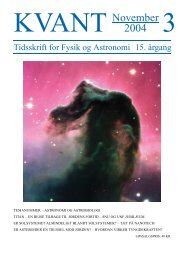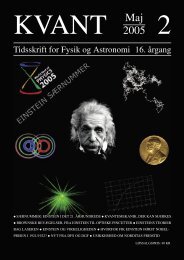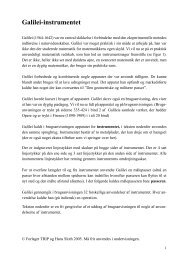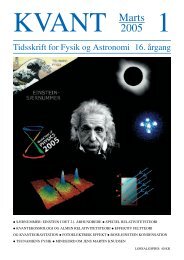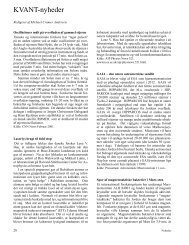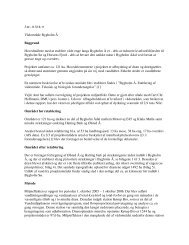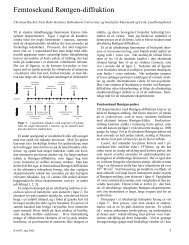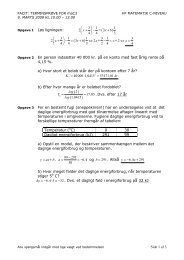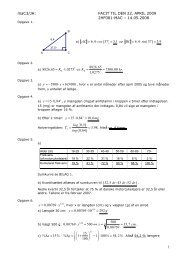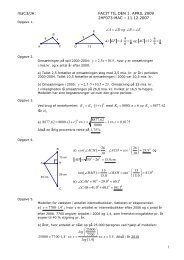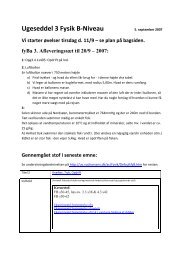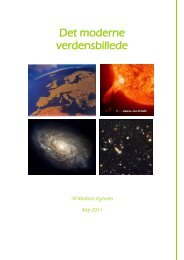Chapter 7 The Outer Planets
Chapter 7 The Outer Planets
Chapter 7 The Outer Planets
You also want an ePaper? Increase the reach of your titles
YUMPU automatically turns print PDFs into web optimized ePapers that Google loves.
220 <strong>Chapter</strong> 7 <strong>The</strong> <strong>Outer</strong> <strong>Planets</strong><br />
27 Compare and contrast Valhalla on Callisto with the<br />
Caloris Basin on Mercury.<br />
28 Can we infer from naked-eye observations that<br />
Saturn is the most distant of the planets visible without<br />
a telescope? Explain.<br />
29 As seen by Earth-based observers, the intervals<br />
between successive edge-on presentations of Saturn’s rings<br />
alternate between 13 years 9 months and 15 years<br />
9 months. Why are these two intervals not equal?<br />
DISCUSSION QUESTIONS<br />
32 Suppose that you were planning a mission to Jupiter<br />
employing an airplanelike vehicle that would spend many<br />
days, even months, flying through the Jovian clouds. What<br />
observations, measurements, and analyses should this<br />
aircraft make? What dangers might it encounter, and what<br />
design problems would you have to overcome?<br />
33 Discuss the possibility that Europa, Ganymede, or<br />
Callisto might harbor some sort of marine life.<br />
34 Suppose you were planning separate missions to each<br />
of Jupiter’s Galilean moons. What questions would you<br />
want these missions to answer, and what kinds of data<br />
would you want your spacecraft to send back? Given the<br />
WHAT IF …<br />
37 Jupiter, at its present location, were a star? What<br />
would Earth be like? Hint: Recall that to be a star, Jupiter<br />
would have to have 75 times more mass than it has today.<br />
38 Jupiter had formed at one-third its present distance of<br />
5.2 AU from the Sun? What would Earth be like?<br />
39 Io were struck by another object of similar size?<br />
Hint: You can create a variety of different scenarios by<br />
WEB/CD-ROM QUESTIONS<br />
41 Moving Weather Systems on Jupiter Access<br />
and view the video “<strong>The</strong> Great Red Spot” in<br />
<strong>Chapter</strong> 7 of the Discovering the Universe Web<br />
site or CD-ROM. (a) Near the bottom of the video<br />
window you will see a white oval moving from left to<br />
right. By stepping through the video one frame at a time,<br />
estimate how long it takes this oval to move a distance<br />
equal to its horizontal dimension. (Hint: You can keep<br />
track of time by noticing how many frames it takes a<br />
VIDEO 7.2<br />
30 Compare and contrast the internal structures of<br />
Jupiter and Saturn with the internal structures of Uranus<br />
and Neptune. Can you propose an explanation for why<br />
the differences between these two pairs of planets<br />
occurred?<br />
31 Neptune has the third largest mass of all the planets,<br />
but Uranus has the third largest diameter. Reconcile these<br />
two facts.<br />
different environments on the four satellites, how would<br />
the designs of the four spacecraft differ?<br />
35 NASA and the Jet Propulsion Laboratory have<br />
tentative plans to place spacecraft in orbit about Uranus<br />
and Neptune in this century. What kinds of data should be<br />
collected and what questions would you like to see<br />
answered by these missions?<br />
36 Would you expect the surfaces of Pluto and Charon to<br />
be heavily cratered? Explain.<br />
imagining the impacting body striking from different<br />
directions and with different speeds and at different angles.<br />
40 Jupiter were orbiting in the opposite direction that it<br />
actually is? What effects might this have on the other<br />
planets? Would this change affect Earth? If so, how?<br />
feature in the Great Red Spot, at the center of the video<br />
window, to move in a complete circle around the center of<br />
the spot. <strong>The</strong> actual time for this feature to complete a circle<br />
is about six days.) (b) <strong>The</strong> horizontal dimension of the white<br />
oval is about 4000 km. At what approximate speed (in<br />
km/hr) does the white oval move? (Speed = distance/time).<br />
42 Search the Web, especially the Web sites at NASA’s Jet<br />
Propulsion Laboratory and the European Space Agency,




